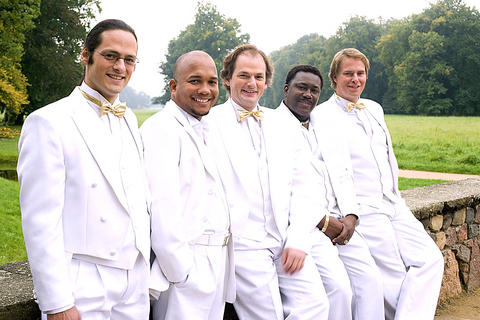The world lost one of the great popularizers of opera Sept. 6 with the death of Luciano Pavarotti. Like the full-bodied tenor, the Klazz Brothers have marketed classical music to a broad audience.
It all started in Havana, Cuba, when a trio of classically trained musicians from Germany was in town with the Dresden Orchestra and happened upon two Cuban percussionists. After a few moment's conversation they realized they shared a curious common musical ground. That meeting spawned a blend of European classical elements mixed with swing and Latin jazz and the diversity of Cuban rhythms.
The Klass Brothers and Cuban Percussion are in town for a one-off concert tonight at the National Concert Hall, where they will team up with the National Symphony Orchestra (NSO) - led by Roger Epple - to play a number of songs that fuse classical and Latin music. Featured songs include Carmen Cuban, Summertime and Mambozard.

PHOTO: COOOURTESY OF NTCH
The ensemble will then take its Cuban and classical fusion to Taichung tomorrow for a free concert at the Fulfillment Amphitheatre (圓滿戶外劇場), in Hsinwen Forest Park.
The Klazz Brothers are made up of bassist Kilian Forster, pianist Tobias Forster, and drummer Tim Hahn and Cuban Percussion comprises the talented Alexis Herrera Estevez and Elio Rodriguez Luis.

June 2 to June 8 Taiwan’s woodcutters believe that if they see even one speck of red in their cooked rice, no matter how small, an accident is going to happen. Peng Chin-tian (彭錦田) swears that this has proven to be true at every stop during his decades-long career in the logging industry. Along with mining, timber harvesting was once considered the most dangerous profession in Taiwan. Not only were mishaps common during all stages of processing, it was difficult to transport the injured to get medical treatment. Many died during the arduous journey. Peng recounts some of his accidents in

“Why does Taiwan identity decline?”a group of researchers lead by University of Nevada political scientist Austin Wang (王宏恩) asked in a recent paper. After all, it is not difficult to explain the rise in Taiwanese identity after the early 1990s. But no model predicted its decline during the 2016-2018 period, they say. After testing various alternative explanations, Wang et al argue that the fall-off in Taiwanese identity during that period is related to voter hedging based on the performance of the Democratic Progressive Party (DPP). Since the DPP is perceived as the guardian of Taiwan identity, when it performs well,

The Taiwan People’s Party (TPP) on May 18 held a rally in Taichung to mark the anniversary of President William Lai’s (賴清德) inauguration on May 20. The title of the rally could be loosely translated to “May 18 recall fraudulent goods” (518退貨ㄌㄨㄚˋ!). Unlike in English, where the terms are the same, “recall” (退貨) in this context refers to product recalls due to damaged, defective or fraudulent merchandise, not the political recalls (罷免) currently dominating the headlines. I attended the rally to determine if the impression was correct that the TPP under party Chairman Huang Kuo-Chang (黃國昌) had little of a

At Computex 2025, Nvidia CEO Jensen Huang (黃仁勳) urged the government to subsidize AI. “All schools in Taiwan must integrate AI into their curricula,” he declared. A few months earlier, he said, “If I were a student today, I’d immediately start using tools like ChatGPT, Gemini Pro and Grok to learn, write and accelerate my thinking.” Huang sees the AI-bullet train leaving the station. And as one of its drivers, he’s worried about youth not getting on board — bad for their careers, and bad for his workforce. As a semiconductor supply-chain powerhouse and AI hub wannabe, Taiwan is seeing